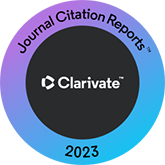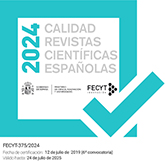The prosody of absolute and reiterative questions in the Castilian of the Leonese Páramo: Falling patterns and phonological lengthening
DOI:
https://doi.org/10.3989/loquens.2024.e107Keywords:
prosody, Sp_ToBI, absolute questions, duration, AsturleonesAbstract
The present study aims to describe and analyse the prosody of total interrogative sentence in the Leonese Páramo within the context of the Romance linguistic varieties of the northern Iberian Peninsula, which exhibit a descending intonational pattern for this type of sentence. A corpus consisting of 74 interrogative sentences from 11 native speakers from the Páramo Bajo has been compiled and analysed using the Sp_ToBI prosodic annotation system. The analyse paid special attention to the behaviour of F0 movement and the relation between the duration of final and medial syllables. The study concludes that ascending-descending patterns (¡H* L% and L+H* HL%) are predominant in the examined region, and prototypical ascending patterns of standard Spanish are not observed. Additionally, there is a tendency towards lenghtening the final syllable in interrogative sentences, particularly notable for the descending nuclear configuration H+L* L%.
Downloads
References
Alvar, M. (1999). Atlas Lingüístico de Castilla y León. Junta de Castila y León, Consejería de Educación y Cultura.
Baltazani, M., Coleman, J., Passoni, E. & Przedlacka, J. (2022). Echoes of Past Contact: Venetian Influence on Cretan Greek Intonation. Language and Speech, 0(0). https://doi.org/10.1177/00238309221091939 PMid:35549764 PMCid:PMC11141085
Bargiela, V. (2022). Dedialectalisation of intonative patterns of yes-no questions in León, Zamora, Salamanca and Palencia. Estudios de Fonética Experimental, 32, 149-160.
Beckman, M., Díaz-Campos, M., McGory, J. T. & Morgan, T.A. (2002). Intonation across Spanish, in the Tones and Break Indices framework, Probus, 14, 9-36. https://doi.org/10.1515/prbs.2002.008
Boersma, P. & Weenink, D. (2021). Praat: doing phonetics by computer[Programa de ordenador]. Versión 6.2.03, descargada el 10 de septiembre de 2021 de http://www.praat.org
Clark, B. (2017). Pragmatics and Intonation. Oxford Research Encyclopedia of Linguistics. Oxford University Press. https://doi.org/10.1093/acrefore/9780199384655.013.208
Congosto Martín, Y. (2016). Modelos entonativos de las interrogativas absolutas en el habla de Extremadura. Loquens3 (2). https://doi.org/10.3989/loquens.2016.032 https://doi.org/10.3989/loquens.2016.032
Congosto Martín, Y., Díaz Gómez, L., Viejo Lucio-Villegas, M. & Fernández Rodríguez, R. (2010). Estudio contrastivo de la entonación del castellano de Don Benito y del asturiano de Mieres en el marco del Proyecto AMPER. En M.Iliescu, HSiller-Runggaldier, P.Danler (Eds.) Actes du XXVe CILPR Congrès International de Linguistique et de Philologie Romanes. De Gruyter, 2-53. https://doi.org/10.1515/9783110231922.2-53
Cuevas Alonso, M. & López Bobo, M. J. (2011). Dialectos en contacto y prosodia: Análisis contrastivo de la entonación del oriente y occidente de Cantabria. Revista Internacional de Lingüística Iberoamericana, 17, 39-52.
Díaz Gómez, L., Muñiz Cachón, M., López Bobo, J., González Rodríguez, R. & Cuevas Alonso, M. (2007). La entonación en dos zonas rurales del centro de Asturias. Archivum LVI, 263-289.
Elordieta, G. & Masa, L. (2020). Los tonemas de la fala en habla conversacional y leída: similitudes y diferencias con el español, gallego y portugués. Huarte de San Juan. Filología y didáctica de la lengua, 20, 51-76. https://doi.org/10.48035/rhsj-fd.20.3
Elordieta, G., Masa, L. & Romera, M. (2020). Intonational analysis of the variety of Spanish spoken in Cáceres. Estudios de Fonética Experimental, 29, 215-239.
Elvira-García, W. (2016). La prosodia de las construcciones insubordinadas conectivo-argumentativas del español [Tesis Doctoral]. Universitat de Barcelona, Cataluña.
Elvira-García, W. (2020). Fusión de patrones entonativos en variedades lingüísticas en contacto: el caso de las interrogativas del español de León. Sintagma, 32, 71-84. https://doi.org/10.21001/sintagma.2020.32.05
Elvira-García, W. (2022). Aportación relativa de las modalidades interrogativa y declarativa a las clasificaciones dialectométricas. Nueva Revista de Filología Hispánica, LXX (1), 27-51. https://doi.org/10.24201/nrfh.v70i1.3783
Elvira-García, W., Roseano, P., Fernández-Planas, A. M. & Martínez-Celdrán, E. (2016). A tool for automatic transcription of intonation: Eti_ToBI a ToBI transcriber for Spanish and Catalan. Language Resources and Evaluation, 50(4), 767-792. https://doi.org/10.1007/s10579-015-9320-9
Escandell-Vidal, M. V. (1999). Los enunciados interrogativos. Aspectos semánticos y pragmáticos. En Bosque, I. & Demonte, V. Gramática Descriptiva de La Lengua Española: Entre La Oración y El Discurso-Morfología, 3.
Estebas-Vilaplana, E. & Prieto, P. (2008). La notación prosódica del español: una revisión del Sp_ToBI. Estudios de Fonética Experimental, 17, 265-283.
Estebas-Vilaplana, E. & Prieto. P. (2010). Castillian Spanish intonation. En Prieto, P. & Roseano, P. (Eds.): Transcription of Intonation of the Spanish Language (pp. 17-48). Lincom Europa.
Face, T. (2008). The intonation of Castillian Spanish declaratives and absolute interrogatives. Lincom Europe.
Fernández Planas, A. M., Dorta Luis, J., Muñiz Cachón, C., Roseano, P., Elvira-García, W. & Cerdà Massó, R. (2017). La prosodia palentina en el Atlas Multimedia de Prosodia del Espacio Románico en España. Anadiss, hors série, 61-76.
Fernández Planas, A. M., Dorta, J., Muñiz Cachón, C., Roseano, P., Elvira-García, W. & Cerdà Massó, R. (2020). León y Palencia: dos patrones entonativos en las interrogativas absolutas neutras en el español europeo actual. Zeitschrift für romanische Philologie, 136 (1), 84-105. https://doi.org/10.1515/zrp-2020-0004
Fernández Rei, E. (2016). Dialectal, historical and sociolinguistic aspects of Galician intonation. Dialectologia, número especial, VI, 147-169.
Fernández Rei, E. (2019a). La entonación en las periferias de la Romania: Galicia y Calabria. Quaderni del Dipartimento di Linguística dell'Università della Calabria, 27, 165-183.
Fernández Rei, E. (2019b). Galician and Spanish in Galicia: prosodies in contact. Spanish in Context, 16 (3), 438-461. https://doi.org/10.1075/sic.00046.fer
Fernández Rei, E. (2019c). La entonación de las variedades ibéricas occidentales. En J.Dorta (Ed.) Investigación geoprosódica. Amper: análisis y retos (pp. 25-46). Iberoamericana Vervuert. https://doi.org/10.31819/9783964568229-003
Fernández Rei, E. & Moutinho, L. (2006). A fronteira prosódica do minho: ¿tamén fronteira prosódica?. En C.Mourón y T. I.Moralejo (eds.). Studies in Contrastive Linguistics. Proceedings of the 4th International Contrastive Linguistics Conference (pp. 265-276). Universidade de Santiago de Compostela.
Frota, S. (2014). The intonational phonology of European Portuguese. En Sun-AhJun (Ed.). Prosodic Typology II: The Phonology of Intonation and Phrasing (pp. 6-42). Oxford University Press. https://doi.org/10.1093/acprof:oso/9780199567300.003.0002
Frota, S. & Prieto, P. (2015). Intonation in Romance. Oxford University Press. https://doi.org/10.1093/acprof:oso/9780199685332.001.0001
García de Diego, V. (1946). Manual de dialectología española. Ediciones Cultura Hispánica.
García Martínez, J. (2020). El páramo leonés y los recursos hídricos: transformaciones en época contemporánea. (Trabajo final de grado no publicado. Universidad de León, Castilla y León.
Gutiérrez González, J. A. (1996). El Páramo Leonés: entre la Antigüedad y la Alta Edad Media. Stvdia historica, Historia medieval, 14, 47-96.
Hayes, B. & Lahiri, A. (1991). Durationally specified intonation in English and Bengali. En Sundberg, J., Nord, L. & Carlson, R. (Eds.). Music, language, speech, and brain (pp. 78-91). Basingstoke. https://doi.org/10.1007/978-1-349-12670-5_7
Hualde, J. I. & Prieto, P. (2015). «Intonational variation in Spanish». En Frota, S. & Prieto, P. (Eds.): Intonation in Romance. Oxford University Press. https://doi.org/10.1093/acprof:oso/9780199685332.003.0010
Ladd, D. R. (1996). Intonational Phonology. Cambridge University Press.
López Bobo, M. J. & Cuevas-Alonso, M. (2010). Cantabrian Spanish intonation. En P.Prieto & P.Roseano (Eds.). Transcription of Intonation of the Spanish language (pp. 49-86). Lincom.
Menéndez Pidal, R. (1906). El dialecto leonés. Revista de Archivos, Bibliotecas y Museos, 10, 128-172.
Michnowicz, J. & Barnes, H. (2013). A Sociolinguistic Analysis of Pre-nuclear Peak Alignment in Yucatán Spanish. En How, C. (Ed.). Selected Proceedings of the 15th Hispanic Linguistics Symposium (pp. 221-235). Cascadilla Proceedings Project.
Montero Curiel, P. (2004). El dialecto leonés y el "Arlas Lingüístico de Castilla y León". Anuario de Estudios Filológicos, 27, 191-205. https://dehesa.unex.es:8443/handle/10662/845
Muñiz Cachón, C. (2013). La entonación asturiana nel marcu de les llingües romániques: los atles prosódicos. Lletres asturianes: Boletín Oficial de l'Academia de la Llingua Asturiana, 109, 11-28.
Muñiz Cachón, C. (2020). Índices entonativos de modalidad entre enunciados declarativos e interrogativos con final descendente: variedades geoprosódicas de Asturias. Entrepalavras, 10(1), 283-302. https://doi.org/10.22168/2237-6321-11778
Muñiz Cachón, C., Díaz Gómez, L., Alvarellos Pedrero, M. & González Rodríguez, R. (2010). La prosodia d'Asturies. En A. M.Cano González. (Coord.). Homenaxe al Profesor Xosé Lluis García Arias (pp. 279-315). Academia de la Llingua Asturiana.
Muñiz Cachón, C. & Roseano, P. (2021). Prosodia del asturiano centromeridional: Rasgos característicos y anotación en Astur_ToBI. En B.Blecua, J.Cicres, M.Espejel y M. J.Machuca (Eds.) Propuestas en fonética experimental: enfoques metodológicos y nuevas tecnologías; Memorias del VIII Congreso Internacional de Fonética Experimental (pp. 210-214). Girona: Universitat de Girona.
Pierrehumbert, J. (1980).The Phonetics and Phonology of English Intonation [Tesis Doctoral]. Massachussetts Institute of Technology, Estados Unidos.
Prieto, P. (2003). Efectos de coarticulación tonal en choques acentuales. En E.Herrera & P.Martín butragueño (Eds.). La tonía: dimensiones fonéticas y fonológicas (pp. 187-218). El Colegio de México.
Prieto, P., Aguilar, L., Mascaró, I., Torres-Tamarit, F. & Vanrell, M. (2009). L'etiquetatge prosòdic Cat-ToBI. Estudios de Fonética Experimental, XVIII, 287-309.
Rischel, J. (1974). Topics in West Greenlandic phonology. Annual Report of the Institute of Phonetics University of Copenhagen, 9, 253-261. https://doi.org/10.7146/aripuc.v9i.130978
Roettger, T. B. & Grice, M. (2019). The tune drives the text : Competing information channels of speech shape phonological systems. Language Dynamics and Change, 9(2), 265-298. https://doi.org/10.1163/22105832-00902006
Roseano, P. (Enero2017). El 'tonal crowding' en español y otras lenguas románicas en la Teoría de la Optimidad. XLVI Simposio de la Sociedad Española de Lingüística. Madrid.
Roseano, P. (2018). L'amuntegament tonal en castellà, català i friülà en la Teoria de l'Optimitat. Sintagma, 30, 23-37. https://doi.org/10.21001/sintagma.2018.30.02
Roseano, P. (2020). Análisis estadísticu de les distancies prosódiques ente los dialeutos del asturianu. Lletres Asturianes, 11, 13-40. https://doi.org/10.17811/llaa.122.2020.13-40
Roseano, P., Fernández Planas, A. M., Elvira-García, W. & Martínez Celdrán, E. (2015). Contacto lingüístico y transferencia prosódica: El caso del alguerés. Dialectologia et Geolinguistica, 23, 95-123. https://doi.org/10.1515/dialect-2015-0006
Roseano, P. & Rodriquez, F. (2022). The phonology of calls in Ladin: Towards a unified account of chanted vocatives in Romance. Ladinia, 46, 93-136. https://doi.org/10.54218/ladinia.46.93-136
Roseano, P. & Rodriquez, F. (2023). Tune-text accomodation in Optimality Theory: An account of Southern Valencian Catalan yes-no questions. Folia Lingüística, 57(1), 81-134. https://doi.org/10.1515/flin-2022-2052
Røyneland, U. (2010). Vertical convergence of linguistic varieties in a language space. En P.Auer y J. E.Schmidt (Eds.). Language and space. An international handbook of linguistic variation. Volume I: theories and methods (pp. 259-274). De Gruyter Mouton. https://doi.org/10.1515/9783110220278.259
Shang, P.尚培珠, Elvira-García, W. & Roseano, P. (2021). La modalidad interrogativa en español y en chino: un enfoque funcionalista. Círculo de Lingüística Aplicada a la Comunicación, 88, 235-254. https://doi.org/10.5209/clac.78313
Vanrell, M. M., Feldhausen, L., & Astruc, L. (2018). The discourse completion task in Romance prosody research: Status quo and outlook. En I.Feldhausen, K.Fliessbach, & M. M.Vanrell (Eds.), Methods in prosody: A Romance language perspective (pp. 191-227). Language Science Press.
Viejo Lucio-Villegas, M. (2012). Prosodia de los enunciados con estructura sujeto-verbo-objeto (SVO) en dos informantes varones de Santander. Estudios de Fonética Experimental, XXI, 75-107.
Zamora Salamanca, F. J., Carrera de la Red, M., & Meléndez Matías, M. M. (2018). Variación geoprosódica en dos entonaciones de Castilla y León: Análisis de frases declarativas e interrogativas sin expansión. Estudios de Fonética Experimental, 28, 126-139.
Zamora Vicente, A. (1979). Dialectología española. Gredos.
Published
How to Cite
Issue
Section
License
Copyright (c) 2024 Consejo Superior de Investigaciones Científicas (CSIC)

This work is licensed under a Creative Commons Attribution 4.0 International License.
© CSIC. Manuscripts published in both the print and online versions of this journal are the property of the Consejo Superior de Investigaciones Científicas, and quoting this source is a requirement for any partial or full reproduction.
All contents of this electronic edition, except where otherwise noted, are distributed under a Creative Commons Attribution 4.0 International (CC BY 4.0) licence. You may read here the basic information and the legal text of the licence. The indication of the CC BY 4.0 licence must be expressly stated in this way when necessary.
Self-archiving in repositories, personal webpages or similar, of any version other than the final version of the work produced by the publisher, is not allowed.
Funding data
Fundación Bancaria Caixa d'Estalvis i Pensions de Barcelona
Grant numbers LCF/BQ/DR23/12000012














